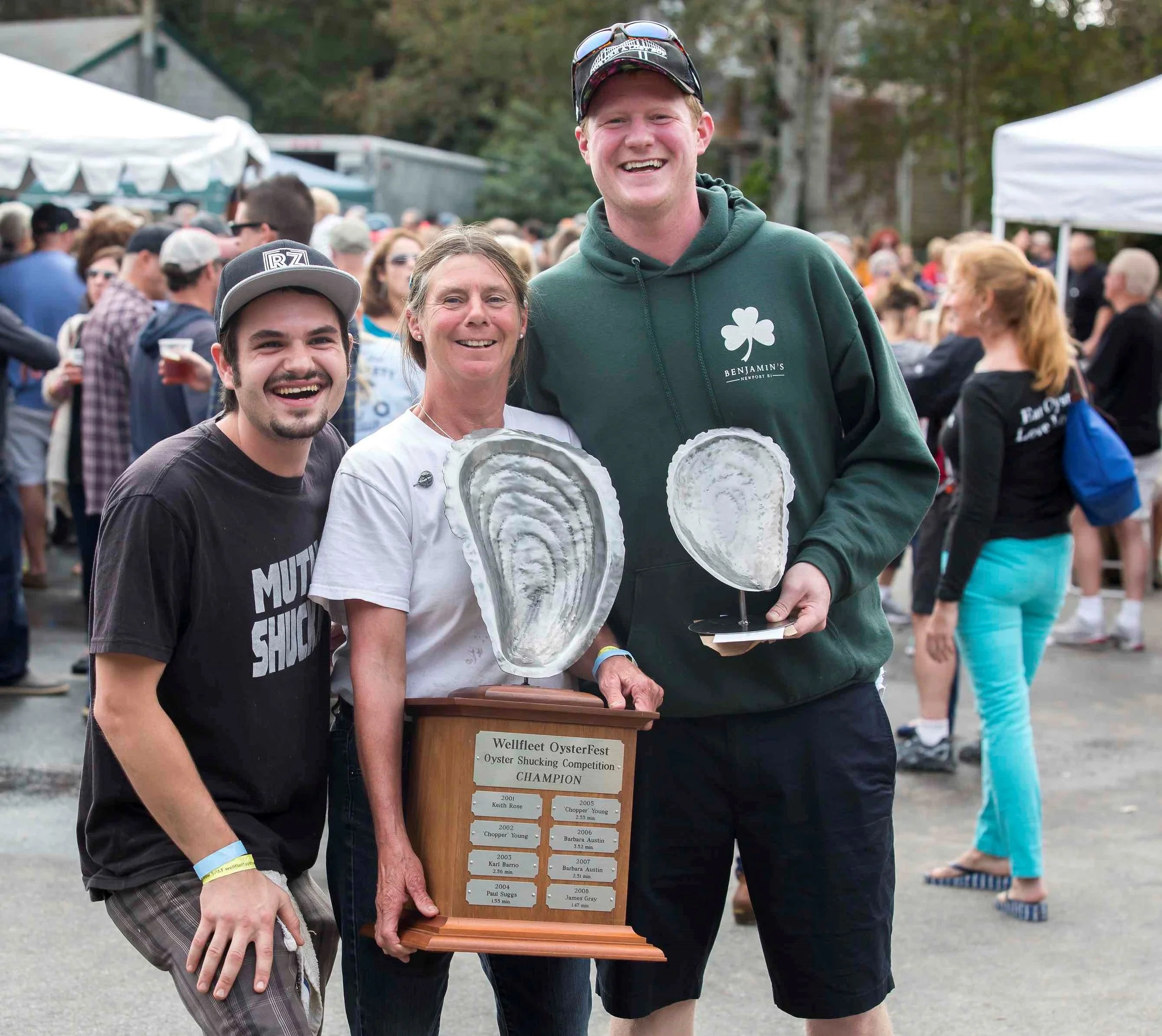Meet a Champion Shucker & Pioneer Shellfisherwoman
Three-time OysterFest Shuck-Off Champion Barbara Austin remembers when it was hard being a woman on the flats
New generations of shellfishermen in Wellfleet include women, as well as men. Barbara Austin with her son Clint Austin, and his partner Kaitlin Sarazin on their grants off Indian Neck. (Photo courtesy Julia Cumes)
Shellfisherwoman Barbara Austin has been going against the grain for more than 35 years, fighting for a woman’s rightful place on the flats. And she’s still enjoying every second of it.
Austin, a regular Wellfleet OysterFest Shuck-Off competitor since the Fest began 23 years ago, is a three-time winner and four-time runner-up and undisputedly the crowd favorite every time she steps on stage. Listening to the cheers and encouragement it’s hard to imagine the early days of her shellfishing career, when she had to endure the taunts of less genial fellow oystermen stopping her on the flats and asking her why she was working a man’s job instead of being home and having babies. “Some of these guys actually asked why I wasn’t at home, barefoot and pregnant.”
Unlike most young shuckers, who learn their tradecraft shucking in raw bars, Austin’s skill and speed was born of necessity. “I started oystering in 1978, the year I graduated high school. In those days, Herring Cove was full of “bananas”, long, thin oysters that grow in clusters and are opened for meat. In those days we could fill five bushel sacks to open and sell by the pound,” she said. A person’s shucking speed determined how much money they could earn. Moreover, she had to shuck fast enough so she could supplement her shellfish earnings by waiting tables. Over 16 years she worked in many well-known eateries and bars, including Rags ‘n Roses, The Brewster Inn, the Jailhouse Tavern, and LoCiceros, to name a few. It was a tough balancing act, she said, especially when her two children, Wendy and Clint, were born.
Barbara Austin teaching a new generation of shellfishermen — grandchildren Everett, Marc, and Asher — about marine life on her Indian Neck grant. (Photo courtesy Julia Cumes)
Clint, who regularly competes against his mom in the Shuck-Off competition, now owns his own Wellfleet oyster farm, Pirate Shellfishing. Wendy is a firefighter and paramedic in Hyannis. Austin said working her grant, shucking oysters, waiting tables, and raising two very active children was a daily challenge. A long-time equestrian, she jokes, “I had to build another fence just to keep my kids corralled.”
For Austin, learning to shuck, and to shuck fast, was a business necessity rather than simply a profession. “Raw bars are an entirely different way of learning how to shuck,” she says. She remembers the days when she would go to a restaurant client with tubs of cut oysters and watch as they dumped the meat into a strainer (keeping the oyster liquor, of course) and weighed the oysters on a scale. She would make $5 a pound, she said. “But that was good money back then.”
Her first major commercial oystering breakthrough took place in the mid-1980s. Austin and ten other Wellfleet shellfishermen had spent five years nagging the powers-that-be agree to open up Indian Neck for new shellfishing grants. Until then, the area’s vast flats were virtually oyster-free. Her fellow shellfishermen included Carl Berrio, Rob McClellan, Sean Rose, Randy William and Woody Clark and his wife Peggy Jennings. Peggy is also considered a true pioneer in the acceptance of women in Wellfleet’s shellfish farming industry. Their success today is irrefutable, their beds covered with oyster “hotels” and “condos,” as they are called, housing millions of future treats for shellfish lovers around the world.
Three multiple Wellfleet Shuck-Off champions posing for a portrait with the Shuck-Off trophies. L to R Cape Codders Kalen Bricault and Barbara Austin with Rhode Island resident Steve Boreen. (Photo courtesy Julia Cumes)
Oystering has become a much more highly-regulated industry since her early days on the flats. Back in the day, most shellfishermen picked wild and the few who had beds used them to store found oysters for market rather than growing them from seed. Before today’s complex regulations to ward off oyster-borne illnesses, maintain chain-of-sales data and safely control gear on oyster beds oystering was a much more relaxed business, Austin said.
Still, she says she wouldn’t trade her job for any other. “I love the changes, to see the different birds and fish each season brings. It’s a never-ending task to keep up with the challenges each brings. Every year is different than the one before, and the one after. I also love my job because what we do is good for the environment, as long as we do it right. Shellfishing is a win-win profession. I’m proud to produce really good food that’s also good for our world.”
FURTHER READING: OysterFest | Voices Around the Pot Belly Stove | Herring River Dike | Upcoming Events



